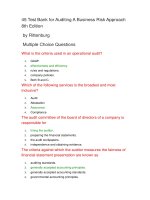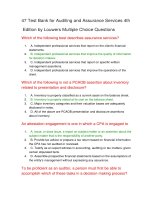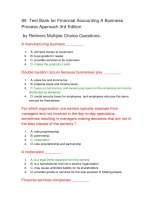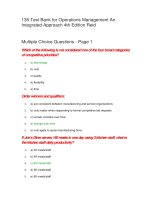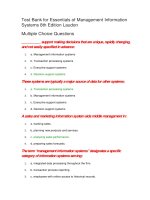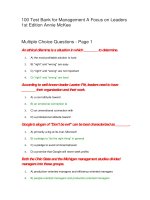100 test bank for auditing a business risk approach 8th edition
Bạn đang xem bản rút gọn của tài liệu. Xem và tải ngay bản đầy đủ của tài liệu tại đây (123.22 KB, 29 trang )
100 Test Bank for Auditing A Business Risk Approach 8th
Edition
Multiple Choice Questions
Congress authorized which of the following organizations to establish
generally accepted accounting principles for public companies?
1.
SEC
2.
APB
3.
AICPA
4.
FASB
The objective of an operational audit is to
1.
evaluate whether laws have been broken by management.
2.
evaluate fairness of presentation of financial statements.
3.
evaluate compliances with company rules and regulations.
4.
evaluate the effectiveness and efficiency with which resources are employed.
Which one of the following is not a key attribute needed to perform
assurance?
1.
subject matter knowledge
2.
independence
3.
established criteria or standards
4.
accounting skills
Auditing is important in a free market society because
1.
the public requires CPAs functioning as divisions of regulatory bodies.
2.
auditors detect all errors and fraud made by company employees.
3.
it provides reliable information based upon which to judge economic performance.
4.
the auditor is an amiable insurance policy for investors.
5.
all of the above are true.
As it relates to an audit, materiality is
1.
not taken into consideration.
2.
related only to the sufficiency of procedures performed.
3.
based upon audit fees.
4.
determined based upon the importance to a user of the financial statements.
Independent professional services that are provided on financial or other
information that improve the quality of decision making are known as
1.
internal auditing.
2.
financial auditing.
3.
assurance services.
4.
attestation services.
What is the criteria used in an operational audit?
1.
GAAP.
2.
effectiveness and efficiency.
3.
rules and regulations.
4.
company policies.
5.
Both B and C.
The auditor of financial statements must make very difficult interpretations
regarding authoritative literature. Additionally, the auditor must
1.
consider whether the application of a generally accepted accounting principle best
portrays the economic activity of the company.
2.
force management to make certain decisions regarding their financial statements.
3.
disregard independence in order to find the underlying truth of the evidence.
4.
establish new criteria by which financial statements may be compared.
Which one of the following statements is not true about internal auditing?
1.
Internal auditing is an objective evaluation function.
2.
Internal auditing is established within an organization.
3.
Internal auditing's purpose is to provide assurance regarding the company's
compliance with stated policies and procedures.
4.
Internal auditing is established as an independent service to regulatory bodies and
creditors.
CPA firms performing public financial statement audits must
1.
register with the American Institute of Certified Public Accountants.
2.
register with the Institute of Auditors.
3.
register with the U.S. General Accounting Office.
4.
register with the Public Company Accounting Oversight Board.
Management of a company is responsible for
1.
hiring the auditor.
2.
preparing the financial statements.
3.
the audit workpapers.
4.
independence and obtaining evidence.
The primary governing board that performs quality reviews on registered CPA
firms that audit public companies is the
1.
PCAOB
2.
GAO
3.
AICPA
4.
FASB
CPAs are licensed by the
1.
PCAOB.
2.
AICPA.
3.
state's board of accountancy.
4.
state's society of CPAs.
Results of the financial statement audit are communicated to users through
a(n)
1.
financial statement.
2.
written management assertion.
3.
audit report.
4.
none of the above.
Auditing is a systematic process that includes all of the following except:
1.
communicating results to users
2.
procuring and evaluating evidence
3.
providing important managerial decisions for a client
4.
comparing evidence regarding assertions to certain established criteria
Which one of the following is an example of management expectations for
independent auditors?
1.
An expert providing a written communication as the product of the engagement.
2.
Individuals who perform day-to-day accounting functions on behalf of the company.
3.
An active participant in management decision making.
4.
An internal source of expertise on financial and other matters.
The internal audit profession has emerged and has become active for all of
the following reasons except:
1.
management's need for an objective appraisal of organizational or departmental
performance
2.
increased internal and external emphasis on effective procedures to detect or prevent
fraud
3.
compliance with Section 404 of the Sarbanes-Oxley Act of 2002
4.
management’s need to delegate the responsibility of the financial statements
An “integrated audit” includes an audit of
1.
the company’s internal controls.
2.
the company’s financial statements.
3.
the company’s compliance with its rules and policies.
4.
Both A and B.
Which of the following services is the broadest and most inclusive?
1.
Audit
2.
Attestation
3.
Assurance
4.
Compliance
The audit committee of the board of directors of a company is responsible for
1.
hiring the auditor.
2.
preparing the financial statements.
3.
the audit workpapers.
4.
independence and obtaining evidence.
The organization that issued the Internal Control, Integrated Framework which
serves as the primary criterion for evaluating the quality of a company’s
internal control system is
1.
PCAOB
2.
COSO
3.
AICPA
4.
GAO
Internal auditors may perform all of the following types of audits except
1.
operational audits.
2.
compliance audits.
3.
computer system audits.
4.
all of the above may be performed by internal auditors.
Which one of the following is not a management expectation for independent
auditors?
1.
an outside source of expertise on accounting matters
2.
individuals who perform tests and draw conclusions on assertions
3.
a participant in management decision making
4.
a provider of a written communication
The public expects auditors to
1.
understand and enforce principles that best portray the spirit of FASB concepts.
2.
be neutral to preparers and users of financial information.
3.
recognize that the public are the primary users of audit services.
4.
take more responsibility for the discovery of fraud.
5.
all of the above are expectations of the public.
The need for assurance services arises for all of the following reasons
EXCEPT:
1.
potential bias in providing information.
2.
Closeness between a user and the organization.
3.
complexity of the processing systems.
4.
remoteness between a user and the organization.
The criteria against which the auditor measures the fairness of financial
statement presentation are known as
1.
auditing standards.
2.
generally accepted accounting principles.
3.
generally accepted accounting standards.
4.
governmental accounting principles.
Which of the following is not a component of assurance services?
1.
information or a process on which the assurance services is provided.
2.
report to a third party.
3.
a user or a group of users who derive value from the service provided.
4.
a service provider.
A service that always requires that a report is provided to a third party is
1.
assurance
2.
attestation
3.
audit
4.
Both B and C.
The audit agency for the U. S. Congress is the
1.
SEC.
2.
GAO.
3.
IIA.
4.
AICPA.
The AICPA remains a valuable organization because of its continuing
involvement in
1.
the audit standard setting process.
2.
regulation and enforcement of the audit profession.
3.
education and administration of the CPA exam.
4.
promulgation of accounting standards.
Which of the following are part of the attest process?
1.
communicating the conclusions reached to a third party
2.
guaranteeing the accuracy of the books and records
3.
evaluating evidence against objective criteria
4.
A and C
5.
B and C
Which type of auditor may perform a financial statement audit?
1.
external auditor.
2.
internal auditor.
3.
governmental auditor.
4.
Both A and C.
5.
All of the above.
Users of the audit report can reasonably expect the audited financial
statements to be.
1.
include complete information and contain all financial disclosures.
2.
presented fairly according to the substance of GAAP.
3.
free from all errors.
4.
all of the above.
5.
none of the above.
Which one of the following is a potential problem with management's
communication of financial information that causes third parties to desire the
independent auditor's assessment of the financial statement presentation?
1.
complexity of transactions affecting the financial statements
2.
lack of criteria on which to base information
3.
remoteness of the user from the organization
4.
A and C
5.
A and B
An audit which has as its purpose the evaluation of the economy and
efficiency with which resources are employed is known as a(n)
1.
financial audit.
2.
compliance audit.
3.
operational audit.
4.
governmental audit.
Which one of the following is not a provider of assurance services?
1.
CPAs
2.
internal auditors
3.
governmental auditors
4.
AICPA
An expectation of the public is that the auditor will recognize that the primary
users of audit assurance are
1.
the clients.
2.
the Public Company Accounting Oversight Board.
3.
members of management.
4.
third-party users.
Which type of auditor would typically perform an operational audit?
1.
external auditor.
2.
internal auditor.
3.
governmental auditor.
4.
Both B and C.
5.
All of the above.
Which one of the following is not a critical component of assurance services?
1.
a process on which service is provided
2.
an assurance service provider
3.
a user who derives value
4.
a CPA
Assurance services may include which of the following?
1.
attesting to financial statements
2.
examination of the economy and efficiency of governmental operations
3.
evaluation of a division's performance for management
4.
tax preparation services
5.
A, B, and C only
The Certified Internal Auditor program is administered by the
1.
AICPA.
2.
IIA.
3.
state's board of accountancy.
4.
state's society of CPAs.
Third-party users of the audit report expect the auditor to do all of the
following except:
1.
to evaluate measurements and disclosures made by management
2.
to provide a biased evaluation of the financial statements
3.
to determine whether financial statements are presented in accordance with GAAP
4.
to gather sufficient evidence to support their opinion
Which one of the following is not part of the attest process?
1.
gathering evidence about assertions
2.
proving the accuracy of the books and records
3.
evaluating evidence against objective criteria
4.
communicating the conclusions reached
What is the criteria used in a compliance audit?
1.
GAAP.
2.
effectiveness and efficiency.
3.
rules and regulations.
4.
company policies.
5.
Both C and D.
Users can reasonably expect audited financial statements to be
1.
complete and contain all important financial disclosures, be free from material
misstatements and be presented fairly according to GAAS.
2.
complete and contain all important financial disclosures, be free from material
misstatements and be presented fairly according to GAAP.
3.
complete, be accurate and be presented fairly according to GAAP.
4.
complete and contain all important financial disclosures, be free from all misstatements
and be presented fairly according to the substance of GAAS.
True - False Questions
Auditors of public companies need not adhere to the requirements of
statutory or regulatory organizations.
1.
True
2.
False
Auditors need only understand the rules of accounting as the principles are
outdated.
1.
True
2.
False
Internal auditing only provides assurance services to clients.
1.
True
2.
False
Auditing is the process of verifying the accuracy of the financial statements.
1.
True
2.
False
The execution of solutions to issues brought to light by internal auditors are
the responsibility of management of the organization.
1.
True
2.
False
The American Institute of CPAs sets auditing standards for non-publicly
traded companies.
1.
True
2.
False
A CPA automatically qualifies as an assurance provider in all areas of
business.
1.
True
2.
False
Attestation is confined to an audit of client financial statements.
1.
True
2.
False
Though often relying on the FASB, the SEC has authority to establish GAAP
for publicly traded companies.
1.
True
2.
False
An audit and an assurance service both require a report to a third party.
1.
True
2.
False
An audit is a form of an attestation service.
1.
True
2.
False
Generally accepted accounting principles provide the criteria against which
the auditor measures the fairness of financial statement presentation.
1.
True
2.
False
The internal auditor is a primary provider of assurance services.
1.
True
2.
False
U.S. nonpublic companies will have an audit performed in accordance with
generally accepted auditing standards that have been promulgated by the
PCAOB.
1.
True
2.
False
Operational audits are designed to determine if the company’s financial
statements are prepared in compliance with GAAP.
1.
True
2.
False
A bank using Milton Company's financial statements to determine the
creditworthiness of a potential loan to Milton is a good example of the need
for unbiased reporting.
1.
True
2.
False
The degree of confidence that users place on management's financial
statements is higher than that placed on audited financial statements because
few users have direct knowledge of the company's operations and
management is the most knowledgeable about operations.
1.
True
2.
False
The purpose of assurance services is to improve the quality of the information
provided.
1.
True
2.
False
CPA certificates for auditors are issued by state boards of accountancy.
1.
True
2.
False
A plan to converge the U.S. generally accepted auditing standards (GAAS)
with the International Standards on Auditing (ISAs) was developed by the
.AICPA’s Auditing Standards Board (ASB).
1.
True
2.
False
Attestation services are a subset of assurance services and always involve a
report that goes to a third party.
1.
True
2.
False
Businesses that use independent auditors do not need the use of internal
auditors.
1.
True
2.
False
Management is required to comment on the fairness of the company's
financial presentation. This reduces the auditor's legal responsibility for the
opinion rendered on the financial statements.
1.
True
2.
False
The internal auditor is a primary provider of operational audits.
1.
True
2.
False
Independence is only required for assurance service providers.
1.
True
2.
False
Governmental audit standards are developed by the Public Company
Accounting Oversight Board.
1.
True
2.
False
Independence is an attribute necessary to perform assurance services.
1.
True
2.
False
An assertion is a statement about an action, event, condition, or performance
over a specified time period.
1.
True
2.
False
Audited financial statements should be presented fairly according to the
substance of GAAP.
1.
True
2.
False
When the auditor has no reservations about management’s financial
statements, then the report issued is called a qualified report.
1.
True
2.
False
Public Company Accounting Oversight Board provides the criteria against
which the auditor measures the fairness of financial statement presentation
for public companies.
1.
True
2.
False
An auditor must have a good understanding of the risks associated with a
client's industry in order to ensure that the financial statements reflect the
underlying substance of accounting transactions and the economic effects of
such transactions.
1.
True
2.
False
The American Institute of Certified Public Accountants has the primary
authority to set auditing standards for public companies.
1.
True
2.
False
Audited financial statements should be presented fairly according to the
substance of GAAS.
1.
True
2.
False
The need for assurance services arises because the interests of the users of
information may be different from that of the interests of those responsible for
providing information.
1.
True
2.
False
The internal audit profession adheres exclusively to standards set by the
Public Company Accounting Oversight Board.
1.
True
2.
False
An audit of financial statements is a form of attestation service.
1.
True
2.
False
The SEC has authority to establish GAAP for all business enterprises.
1.
True
2.
False
Internal auditing is an objective evaluation function established within an
organization.
1.
True
2.
False
Governmental auditors perform operational and financial statement audits.
1.
True
2.
False
Auditing is the process of attesting to assertions about economic actions and
events.
1.
True
2.
False
Audited financial statements should be free from all errors and fraud.
1.
True
2.
False
The Public Company Accounting Oversight Board was established by the
AICPA in response to Securities law.
1.
True
2.
False
Auditing primarily exists because users need unbiased information on which
to assess management performance and make economic decisions.
1.
True
2.
False
The audit function is unique because it exists to perform services on a
"client" on behalf of shareholders, directors and other parties.
1.
True
2.
False
Free Text Questions
Overview of Financial Statement Audit Define auditing and discuss how its
components fit into an overview of a financial statement audit.
Answer Given
Financial statement auditing has been defined as a “systematic process of actively
obtaining and evaluating evidence regarding assertions about economic actions and
events to ascertain the degree of correspondence between those assertions and
established criteria and communicating the results to interested users.”
Requirements of auditors in public accounting Recent landscape changes in
accounting and auditing developed from corporate fraud and, arguably,
auditor failure. In order to continually lead and adapt to the dynamics of
regulation, principles based accounting practices and auditing standards,
what types of skills and traits are auditors required to possess?
Answer Given
In addition to integrity, ethics and independence, auditors must possess an inherent
ability to understand the client. This pertains not only to the manner in which the
company operates, but the industry in which the client participates. The auditor must
be able to use sound professional judgment and skepticism to perceive issues and
propose solutions. An auditor must understand the environment in which a client does
business. The surrounding economic, cultural and political aspects of a company are
all vital to the auditor's understanding of risks. An auditor must be able to interpret a
complex body of knowledge, apply audit procedures and measure assertions against
the criteria of generally accepted accounting principles. Risks must be adequately
considered for the audit and the client so that the audit firm may reduce exposure in
the marketplace. Information technology used by clients must also be understood by
the auditor so that internal control, prevention and detection of misstatements and the
audit trail might be assessed. Similarly, the auditor must use software to perform an
audit efficiently and adequately.
Objectives of different audit types Compare and contrast the objectives of
financial, compliance, operational and governmental audits. Include in your
answer who performs each type of audit.
Answer Given
Financial audits performed by independent CPAs have as their aim the expression of a
professional opinion as to the overall fairness of the statements in all material respects
and as to the presentation of these statements in accordance with GAAP. External
auditors and governmental auditors may perform them; because of lack of
independence, the internal auditor can only assist the external auditor in the
performance of an audit of their financial statements. Compliance audits are a
systematic process to determine whether or not an entity's activities are carried out in
accordance with standards or policies promulgated by management or regulatory
agencies, e.g., rules, laws or regulations. All three types of auditors, external, internal
and governmental, perform compliance audits regularly. Operational audits are
systematic appraisals of an entity's operations to determine whether an organization's
operations are being carried out in an efficient manner. The criteria used depends very
much on the abilities and knowledge of the auditor in judging the efficiency and
effectiveness of operations and methods to improve them. All three types of auditors
may perform them, i.e., external , internal and governmental, though operational audits
are most closely associated with internal and governmental auditors. Governmental
audits are usually performed by employees of the government and they usually
encompass all three types of audits just mentioned. The major difference is the
governmental orientation. Operational audits for effectiveness and efficiency may be
performed, as well as financial audits for compliance with governmental GAAP, and
compliance audits with laws, rules and regulations.
Attestation versus assurance : Distinguish between attestation services and
assurance services.
Answer Given
Attestation services are a subset of the broader spectrum of assurance services.
Attestation services always involve evaluation of an assertion by one party to a third

